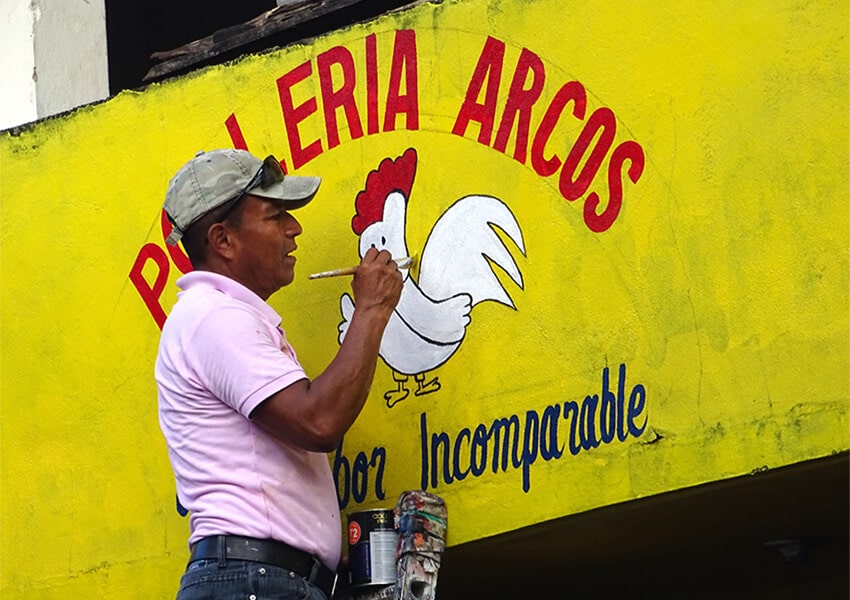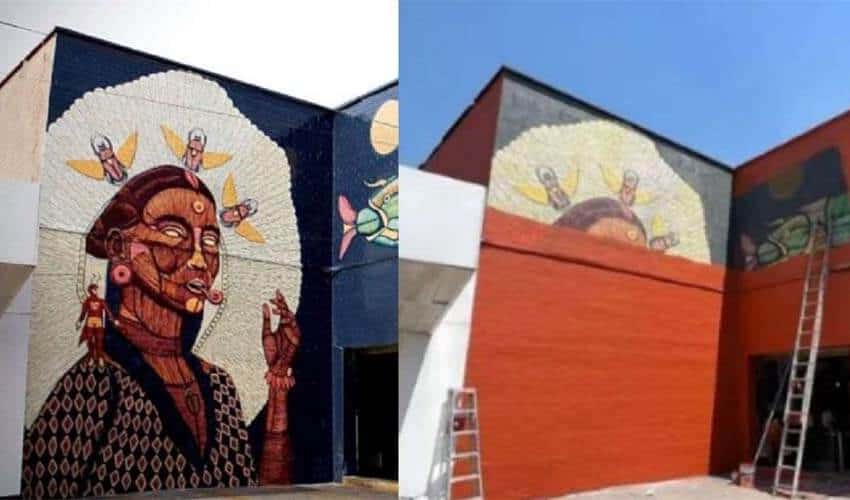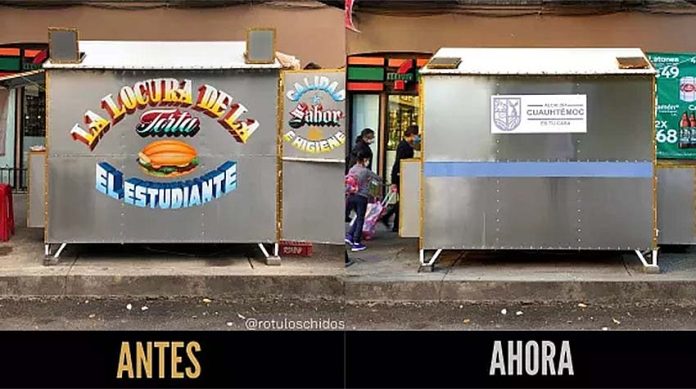When is the painting of a public space blight and when is it something to be valued?
Last year, borough Mayor Sandra Cuevas began a program called the Integrated Journey to Improve the Urban Environment (Jornada Integral de Mejoramiento del Entorno Urbano). Her stated goal is cleaning and organizing the borough, which encompasses the oldest sections of Mexico City. However, some of her efforts have sparked controversy.
All over Mexico City, especially in its lower-class neighborhoods, there are permanent metal stalls on the sidewalk. Most are occupied by food vendors, but they can have other businesses such as those related to cell phones, shoes and even haircuts.
Traditionally, these stalls are decorated with lettering announcing the business’s name as well as images related to it. They are hand-painted by people who do this for a living. These naïf paintings are called rótulos (literally “labels”).

But if you walk around Cuauhtémoc lately, the permanent stalls are now plain white with nothing but the logo of the borough government.
On Twitter, Cuevas explained that the change was part of the “order and discipline” her borough government promotes to improve the look of the streets. Merchants were required to do the painting themselves or face fines.
The loss of the colorful images sparked strong backlash on social media, getting the attention of the Mexico City media. Merchants were told to destroy what is considered by many an aspect of the city’s popular culture and instead promote the government itself. Instead of seeing what you might want across the street, all you see now is a wall of white.
Cuevas perhaps did not improve matters at a May 20 press conference, in which she defended her decision to erase the signs, but then also said as an aside, that they are not art. “They may be the usos y costumbres of Mexico City, but it’s not art.”
For context, it’s useful to know that the Cuevas government is also responsible for the destruction of a number of murals that were painted with permission from previous administrations, including one at the Juárez market near the upscale Roma neighborhood.

In 2020, artist Sego y Ovbal painted Woman in Dialogue with Progress on one of the outer walls of the market. This past March, workers from the borough painted it over with orange paint, causing an uproar in the market and the surrounding community.
Cuevas denies ordering the mural’s destruction and that she is trying to eliminate “any urban expression” in the borough. She fired two of the workers responsible for the mural’s erasure and is negotiating to have it repainted in the same place by the same artist, she said.
People being upset over the elimination of murals is easy enough to understand: the art form has been a major part of modern Mexican culture — even those of the graffiti type — with individuals, private organizations and government agencies encouraging the creation of new artworks, often with themes related to culture and politics. But this uproar — over eliminating what is essentially advertising — might be a little more difficult to understand. But it does make some sense if you know Mexico’s history.
Hand-painted lettering and images to promote businesses and economic events emerged in Mexico around the same time that modern muralism did. At the beginning of the 20th century, many Mexicans were illiterate, so images of the product being promoted were very important, and even more so as small businesses proliferated as cities and the economy grew.

There have been some issues with rótulos, especially large ones painted on public and other freestanding walls without permission, but those on the businesses themselves are sponsored by the owners. And they follow graphic design principles, which have a long and sophisticated history in Mexico.
Rotulistas are not formally trained artists for the most part, but Mexican culture is visually very demanding, especially in chaotic cities where there is much competition for the public’s attention. This cultural sophistication has been the basis of books, scholarly articles, documentaries and even collaborations with fine artists.
The struggle, according to photographer and cultural activist David Léspar, is between the majority of the residents of the borough and a small number of well-to-do residents, who are looking to gentrify the area.
The middle and lower classes are accustomed to and even expect an environment filled with certain colors, images and sounds as an expression of their culture. The upper classes have been exposed to life in developed countries north of Mexico and in Europe. They see the order and uniformity in cities such as London and Washington, DC as “progress.”

For further context: laws mandating certain appearances and limitations to garish advertising do indeed exist in Mexico, most often in colonial-era historic centers being preserved for tourism.
Such restrictions do make sense in places like the historic center of Mexico City, and more upscale neighborhoods such as Roma and Condesa. But Cuevas’ edict applies to the entire borough, even areas such as Doctores, Tepito, Guerrero and others that have always been working class/poor, with little or no attraction for gentrification other than, perhaps, their proximity to the historic center.
Although the Integrated Journey program is promoted as supporting street-based merchants, it has become a hard sell, taking away an important business tool while at the same time adding a significant number of reporting requirements and providing nothing that promotes what locals believe would make the situation better, such as support for better food hygiene.
Leigh Thelmadatter arrived in Mexico 18 years ago and fell in love with the land and the culture in particular its handcrafts and art. She is the author of Mexican Cartonería: Paper, Paste and Fiesta (Schiffer 2019). Her culture column appears regularly on Mexico News Daily.
